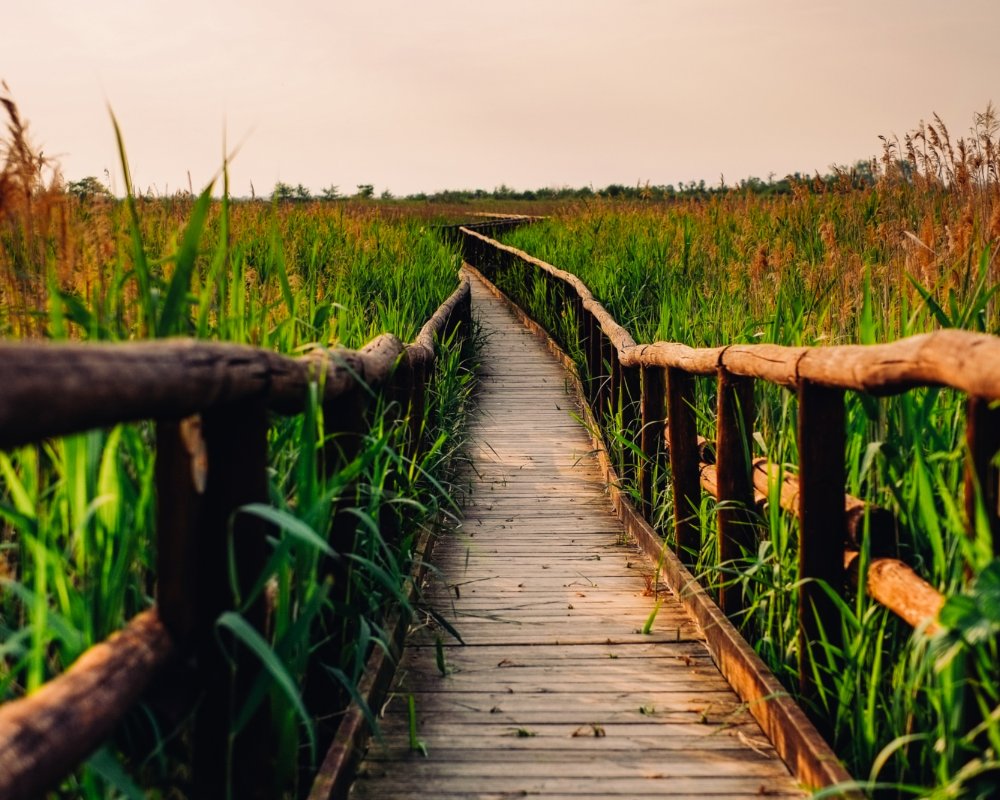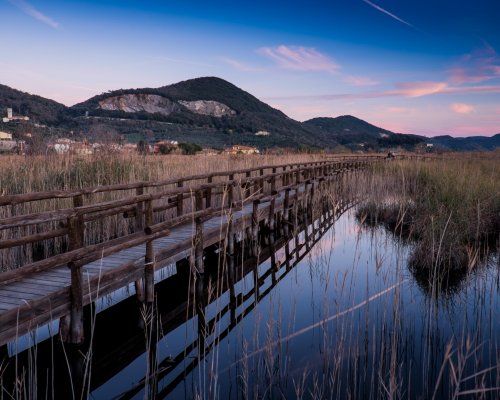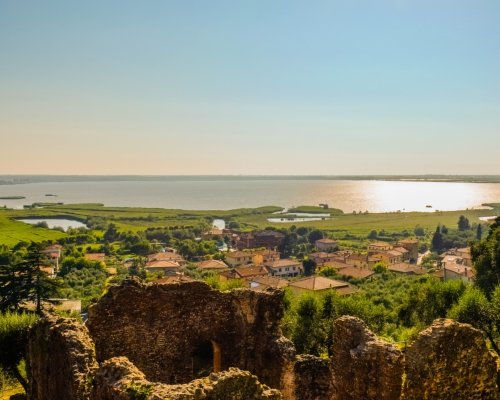


Discover the Tuscan lake that has enchanted and amazed since Roman times
The sound of footsteps, rhythmic, make the wooden beams of the walkway creak. All around, only the chirping of birds and the wind rustling the grass can be heard. We’re in the Versilia, that corner of Tuscany nestled between the Apuan Alps and the sea, in the norther part of the region. A few kilometres from the popular boardwalk in Viareggio, a centuries-old marshland is home to a thriving animal and plant community, Massaciuccoli Lake, which at more than 2,000 square kilometres in size, is the largest retro-dunal wetland in Tuscany.
What is today a large swamp was once a salt water lagoon that underwent slow reclamation efforts. Human settlements began to pop up as early as the Roman era, which are still visible today in the Massaciuccoli Romana archeological area: this is where you can visit the local archeological museum and the ruins of the Venulei Villa, built at the beginning of the 1st century CE, with its bath complex in a position that dominated over the lake and, further down, the coast.
In Massaciuccoli, near the archeological area, many birds reside in the LIPU Oasis of Chiarone, founded in 1979 along with the Migliarino, San Rossore and Massaciuccoli Park. The marshland is located in a place that made it a stop on many people’s journeys and the perfect place to holiday thanks to the variety of the birds here, from the osprey and black-winged stilt to the purple heron and rare glossy ibis.
On the other side of the lake is the village of Torre del Lago, a small hamlet known for being a favourite spot of Giacomo Puccini, who moved into a villa there that is now home to a museum dedicated to the composer.
Around the lake, there are many trails and itineraries that lead visitors through the most evocative environments and which offer excellent vantage points of those corners where water gives way to land and marshy plants.
We leave from the small Massaciucoli port, heading to the LIPU Visitors’ Centre. This is where we find a museum about the marsh’s ecology, with scale models depicting the lagoon environments. From the Visitors’ Centre, take the wooden walkways that dive into the typical marsh vegetation, like rushes and sedges. Along the way, we’ll come across observation huts, built for birdwatching and to take photographs. Indeed, this is where you can find many species of sedentary and migratory birds that live in the various environments: the “transparent” environment, shallows of body water, and the “floating” environment, floating parts of the marsh that are home to endangered plants. There are 260 different known bird species here, including some rare ones. Every day, visitors can also request a canoe for exploring the waters alone or in a group. For reservations, contact the Visitors’ Centre.
We leave from the small Massaciucoli port, heading to the LIPU Visitors’ Centre. This is where we find a museum about the marsh’s ecology, with scale models depicting the lagoon environments. From the Visitors’ Centre, take the wooden walkways that dive into the typical marsh vegetation, like rushes and sedges. Along the way, we’ll come across observation huts, built for birdwatching and to take photographs. Indeed, this is where you can find many species of sedentary and migratory birds that live in the various environments: the “transparent” environment, shallows of body water, and the “floating” environment, floating parts of the marsh that are home to endangered plants. There are 260 different known bird species here, including some rare ones. Every day, visitors can also request a canoe for exploring the waters alone or in a group. For reservations, contact the Visitors’ Centre.
The Sentiero delle Sughere starts at the Oasis, which leads to the high plains beyond the lake. Heading toward the centre of the town, we’ll come across the exposition pavilion stationed before the entrance to the Massaciuccoli Romana, an ancient villa that overlooked the lake in Antiquity. The archeological area is enriched with an excellently repaired mosaic and a museum that illustrates the history of the site, home to the ruins of the Venulei Villa and thermal baths. After visiting the complex, we continue climbing the trail before reaching Compignano, keeping Monte Aquilata to our left. We will shortly come to the town of Crocetta, near Villa Minutoli Tergimi, which sits atop the ruins of an ancient tower from the Lombard era.
The Sentiero delle Sughere starts at the Oasis, which leads to the high plains beyond the lake. Heading toward the centre of the town, we’ll come across the exposition pavilion stationed before the entrance to the Massaciuccoli Romana, an ancient villa that overlooked the lake in Antiquity. The archeological area is enriched with an excellently repaired mosaic and a museum that illustrates the history of the site, home to the ruins of the Venulei Villa and thermal baths. After visiting the complex, we continue climbing the trail before reaching Compignano, keeping Monte Aquilata to our left. We will shortly come to the town of Crocetta, near Villa Minutoli Tergimi, which sits atop the ruins of an ancient tower from the Lombard era.
From Crocetta, we continue along the trail, admiring the spectacular views of the lake and the coast in the direction of Compignano as we dive deep into the woods of oak, chestnut and cork trees, the latter of which, called sughero in Italian, lends its name to the trail. We move in the direction of Compignano, still surrounded by vegetation, passing by Villa Hernandez and Villa Baldini, two other stunning buildings. Villa Baldini, with its splendid Italian garden, was home to Paolina Bonaparte for a short time, a noblewoman and sister of Napoleon. The trail continues to our final destination, Compignano, where we arrive after crossing a cobblestone road that leads to the Church of San Frediano. To get back to the starting point, we need only to retrace our steps.
From Crocetta, we continue along the trail, admiring the spectacular views of the lake and the coast in the direction of Compignano as we dive deep into the woods of oak, chestnut and cork trees, the latter of which, called sughero in Italian, lends its name to the trail. We move in the direction of Compignano, still surrounded by vegetation, passing by Villa Hernandez and Villa Baldini, two other stunning buildings. Villa Baldini, with its splendid Italian garden, was home to Paolina Bonaparte for a short time, a noblewoman and sister of Napoleon. The trail continues to our final destination, Compignano, where we arrive after crossing a cobblestone road that leads to the Church of San Frediano. To get back to the starting point, we need only to retrace our steps.